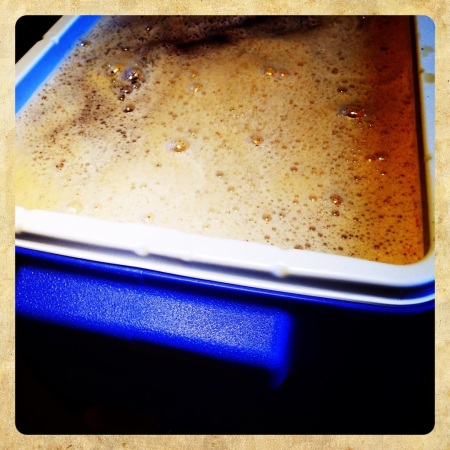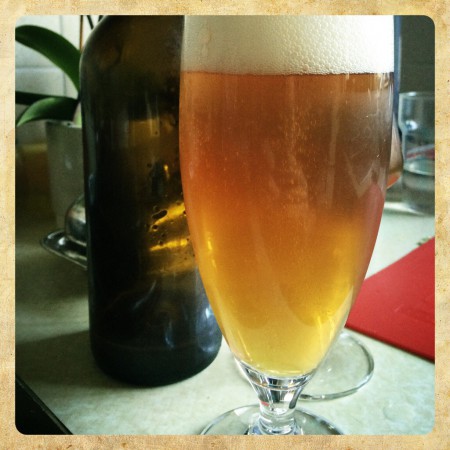I’ve done 3 brews now with the vial of WLP500 yeast I bought recently. The patersbier starter I did with it turned out a bit ropey – huge whiff of sulphur off all of the beers. But the dubbel I repitched the yeast into is tasting extremely promising. And the Belgian blonde might be even better, if the samples I had at bottling time are any indication.
In some ways, all of these brews were leading up this one. It was always my plan to do a dark and strong Belgian ale with the last repitch of this yeast. A Belgian quadrupel (or “Belgian Dark Strong” as it’s known in the BJCP guidelines) was the only choice. I’m a big fan of the Chimay Blue and as WLP500 is in fact the Chimay strain, it seemed like a great choice. I’m using Jamil’s recipe, with just a few minor adjustments. The hops are slightly different (I’m doing a small flavour addition, for a start) but I also want to use up some more of the dark candi syrup I bought for this series of Belgian ales.
Recipe Specifications
Boil Size: 27.90 l
Post Boil Volume: 23.40 l
Batch Size (fermenter): 19.00 l
Bottling Volume: 17.00 l
Estimated OG: 1.098 SG
Estimated Color: 61.4 EBC
Estimated IBU: 30.1 IBUs
Brewhouse Efficiency: 60.00 %
Est Mash Efficiency: 72.2 %
Boil Time: 90 Minutes
Ingredients
6.200 kg Pilsner (2 Row) Bel (3.9 EBC), 62.5 %
1.350 kg Munich Malt (17.7 EBC), 13.6 %
0.450 kg Aromatic Malt (51.2 EBC), 4.5 %
0.450 kg Caramunich Malt (110.3 EBC), 4.5 %
0.450 kg Special B Malt (400.0 EBC), 4.5 %
0.300 kg Wheat Malt, Bel (3.9 EBC), 3.0 %
0.225 kg Melanoiden Malt (39.4 EBC), 2.3 %
0.250 kg Candi Sugar, Dark (541.8 EBC), 2.5 %
0.300 kg Cane (Beet) Sugar (0.0 EBC), 2.5 %
56 g Hallertauer Hersbrucker [3.80 %], 27.0 IBUs
0.50 Items Whirlfloc Tablet (Boil 10.0 mins)
25 g Saaz [4.80 %] – Boil 10.0 min, 3.1 IBUs
12 g Coriander Seed, Boil 5 mins
1.0 pkg Trappist Ale (White Labs #WLP500) (600ml slurry from Little Divil)
Mash Schedule: Bubbles’ Single Infusion, Full Body, Batch Sparge
Total Grain Weight: 9.925 kg
Mash In Add 26.39 l of water at 74.6 C 68.0 C 60 min
Sparge: Batch sparge with 2 steps (Drain mash tun , 11.45l) of 77.0 C water
Mash Day 30/08/2014 – I quite like splitting up the mash and boil into separate “brew days”. I’ve been doing my last few brews like this and it really cuts down on the workload somehow. Mash went well. Was ready to dough in, grain crushed, liquor heated and checked out my recipe notes. I was alarmed to see the recipe specify 26 litres of liquor. Never transferred that much liquor to my MT before. I knew I was dealing with more grain than I’d ever dealt with before, but I started to get worried about all of the grain and liquor actually fitting in the mash tun. It was somewhat foolhardy, but I just went for it and doughed in. A very, very, very close call; but it all fit in the mash with barely a mm left to clamp down the lid. Mashed for 90 mins and was very impressed with the dark, mahogany red of the wort. The only thing is that my mash temperature was a good bit higher than I wanted – I was getting a lot of different readings in different parts of the MT, but I’d say the mash temperature averaged out at 66.5C.
Boil Day 31/08/2014 – All going well until I was looking at the chilling wort and wondering why the cold break wasn’t forming as well as usual. I’d forgotten to add the Whirlfloc. Kicking myself. Running off the boiler wasn’t as easy as the last time either, even though I did it pretty slowly. I might look into doing some finings post-fermentation. I’m also considering a re-brew. To add to my woes, I also came in at an OG of 1.090, but with such a high gravity, it was somewhat expected. Finished the brew in the morning and fermentation had started by evening. Going to ferment at a cooler temperature for 2 or 3 days before warming up to ensure complete fermentation.
02/09/2014 – Was a bit concerned because the kreusen has actually died down slightly, which I wouldn’t have expected at this early stage. Took a temperature reading of 20.8C which is pretty good. Though I still move the FV to a warmer spot, so that it will fully attenuate. Checked BCS for advice and it says to increase the temperature to 22C in the last third of fermentation. I’ll probably exceed that, but that’s no hassle with this particular yeast strain.
03/09/2014 – Took a temperature reading and it’s pretty bang-on. 22.1C. Another 3 or 4 days at that temperature should see it mostly fermented out. I know I’ve said it before, but I love the resilience of these Belgian yeasts! Next summer is going to be saisons and Belgian ales all the way.
22/09/2014 – Bottled with 180g corn sugar (17.5l @ 3.5 vol). Used the same carbonation strategy as the Little Divil, but I haven’t tasted that yet, so hope it’s okay. Got 12 x 500ml and 33 x 330ml bottles from the batch. The aroma from the fermenter was absolutely incredible. Took a FG reading of 1.012 which seems very low to me, but then, I was several points below my target OG, so it’s probably fine. Taste from the trial jar was shockingly alcoholic, but it will just need a couple of months for those flavours to mellow. Great potential. As I suspected, it is extremely hazy and murky, but hopefully some of this will dissipate too.
16/12/2014 – Woefully undercarbonated. Also feels syrupy and under-attenuated. Extremely disappointed as I knew it would not be at its best, but still expected it to be drinkable.
27/02/2015 – Very pleased and relieved to see that this finally carbed up. I brought the crates indoors and roused the yeast at the bottom of each bottle. A month’s patience and hey presto.. The only problem is the lack of clarity – it really is a murky and rather unattractive looking beer. Head retention is unfortunately non-existent too. Flavour has improved a lot, but alcohol is still a tiny bit hot. Another couple months should further smoothen the flavour, but I doubt the clarity will ever improve. That’s what happens when you forget the Whirlfloc.
27/09/2015 – It’s taken a long time, but this beer has really started to grow on me. Lovely spicy, fruit-cake type flavours. It’s not syrupy, as I expecting, still very drinkable. The bitterness is surprisingly prominent, given the long aging it has endured. It will make a nice winter sipper. But I’m still keen to re-brew it, this time not forgetting the finings!
09/02/2016 – This is tasting really good. The alcohols are so smooth now. Big Belgian yeast flavours and lots of dark dried fruits. Still very hazy, which is off putting. It’s also a bit too dark. Would row back on the dark crystal malts on the next attempt.
25/08/2016 – A long time since I sampled one of these. It never dropped bright, even after two years. Very raisiny, bit of oxidation showing possibly. Dried fruit. Slightly burnt caramel. Really enjoyed this.

